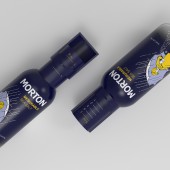
| THE AWARD |
| CATEGORIES |
| REGISTRATION |
| SUBMIT YOUR WORK |
| ENTRY INSTRUCTIONS |
| TERMS & CONDITIONS |
| PUBLICATIONS |
| DATES & FEES |
| METHODOLOGY |
| CONTACT |
| WINNERS |
| PRESS ROOM |
| GET INVOLVED |
| DESIGN PRIZE |
| DESIGN STORE |
| THE AWARD | JURY | CATEGORIES | REGISTRATION | PRESS | WINNERS | PUBLICATIONS | ENTRY INSTRUCTIONS |
Morton Metering Salt Shaker Package by Xunxing liang |
Home > Winners > Design #157265 >Interview |
 |
|
FS: What is the main principle, idea and inspiration behind your design?
XL: The main inspiration behind my design is to address the common issue faced by novice cooks who struggle with accurately measuring the amount of salt to use in their dishes. The design principle revolves around providing a user-friendly solution that allows precise measurement of salt from 1 to 5 grams. This idea was motivated by the need for consistency and accuracy in cooking, aligning with the recommendations from the World Health Organization on salt intake.
FS: What has been your main focus in designing this work? Especially what did you want to achieve?
XL: My main focus was to create a practical and ergonomic salt dispenser that not only simplifies the process of adding salt to food but also promotes healthier eating habits by preventing overuse. I aimed to achieve a balance between functionality and aesthetic appeal, ensuring the product is easy to use with one hand and can be refilled for continuous use.
FS: What are your future plans for this award winning design?
XL: I plan to refine the design based on user feedback and explore potential collaborations with established kitchenware brands to bring this product to market. Additionally, I aim to expand the concept to other seasonings and cooking ingredients, maintaining the core idea of precise measurement.
FS: How long did it take you to design this particular concept?
XL: This project started in September 2023 and was completed in December 2023, taking approximately three months from concept to final design.
FS: Why did you design this particular concept? Was this design commissioned or did you decide to pursuit an inspiration?
XL: This design was a personal initiative inspired by the common challenges faced in home cooking. It was not commissioned; instead, it stemmed from my observation of the need for a more precise and user-friendly salt dispenser.
FS: Is your design being produced or used by another company, or do you plan to sell or lease the production rights or do you intent to produce your work yourself?
XL: Currently, the design is not being produced by another company. I am open to selling or leasing the production rights to a suitable partner who shares my vision for making cooking easier and healthier.
FS: What made you design this particular type of work?
XL: The primary motivation was to solve a real-world problem in a simple yet effective way. By focusing on user experience and the specific needs of home cooks, I wanted to create a product that could make a tangible difference in everyday cooking practices.
FS: Where there any other designs and/or designers that helped the influence the design of your work?
XL: While the core idea was original, I was influenced by the functional aspects of other precise measuring tools and dispensers.
FS: Who is the target customer for his design?
XL: The target customers are home cooks and culinary enthusiasts who value precision and ease of use in their kitchen tools. This includes individuals who are health-conscious and those who appreciate innovative kitchen gadgets.
FS: What sets this design apart from other similar or resembling concepts?
XL: This design stands out due to its precise measurement capability, ergonomic single-hand operation, and the ability to be refilled for continuous use. The combination of a sleek, minimalist design with practical functionality makes it unique in the market.
FS: How did you come up with the name for this design? What does it mean?
XL: The name "Morton Quantitative Salt Dispenser" was derived from the brand Morton, which is synonymous with salt, and the term "quantitative" reflects the product's ability to measure precise amounts of salt. The name aims to convey the core functionality and brand association in a clear and straightforward manner.
FS: Which design tools did you use when you were working on this project?
XL: I used a combination of design software and tools including Adobe Illustrator and Photoshop for visual design, SolidWorks for 3D modeling, and Blender for rendering and simulation. These tools allowed me to create detailed and accurate representations of the final product.
FS: What is the most unique aspect of your design?
XL: The most unique aspect of the design is the precise measurement mechanism that allows users to dispense exactly 1 to 5 grams of salt with a simple, single-hand operation. This level of precision is not commonly found in typical salt dispensers.
FS: Who did you collaborate with for this design? Did you work with people with technical / specialized skills?
XL: While I led the design process, I collaborated with engineers and materials specialists to ensure the feasibility of the design. Their expertise was crucial in refining the dispensing mechanism and selecting suitable materials for production.
FS: What is the role of technology in this particular design?
XL: Technology played a significant role in both the design and prototyping phases. Advanced 3D modeling software helped in visualizing the design, while injection molding and blow molding technologies were essential for creating the physical prototype.
FS: Is your design influenced by data or analytical research in any way? What kind of research did you conduct for making this design?
XL: Yes, the design is heavily influenced by data on recommended salt intake levels from health organizations such as the World Health Organization and the American Heart Association. I conducted research on user behavior, ergonomic studies, and material durability to ensure the design met both health guidelines and user needs.
FS: What are some of the challenges you faced during the design/realization of your concept?
XL: One of the main challenges was ensuring the durability of the dispensing mechanism. The initial prototypes had issues with the catch mechanism breaking, which required adjusting the wall thickness and material composition. Balancing the compact size with the need for clear and accurate measurements also posed a significant challenge.
FS: How did you decide to submit your design to an international design competition?
XL: I decided to submit my design to the A’ Design Award after receiving positive feedback from peers and mentors who recognized the innovation and practicality of the product. Participating in an international competition is a valuable opportunity to gain exposure and validate the design on a global platform.
FS: What did you learn or how did you improve yourself during the designing of this work?
XL: This project taught me the importance of iterative design and prototyping. Each version of the prototype brought new insights and improvements, highlighting the value of persistence and attention to detail. I also enhanced my collaboration skills, learning how to effectively integrate feedback from different disciplines.
FS: Any other things you would like to cover that have not been covered in these questions?
XL: I would like to emphasize the potential social impact of this design. By making it easier to measure and control salt intake, this product can contribute to better health outcomes and raise awareness about the importance of mindful eating. Additionally, I aim to explore sustainable materials for future iterations to align with environmental goals.
FS: Thank you for providing us with this opportunity to interview you.
A' Design Award and Competitions grants rights to press members and bloggers to use parts of this interview. This interview is provided as it is; DesignPRWire and A' Design Award and Competitions cannot be held responsible for the answers given by participating designers.
| SOCIAL |
| + Add to Likes / Favorites | Send to My Email | Comment | View Press-Release |




